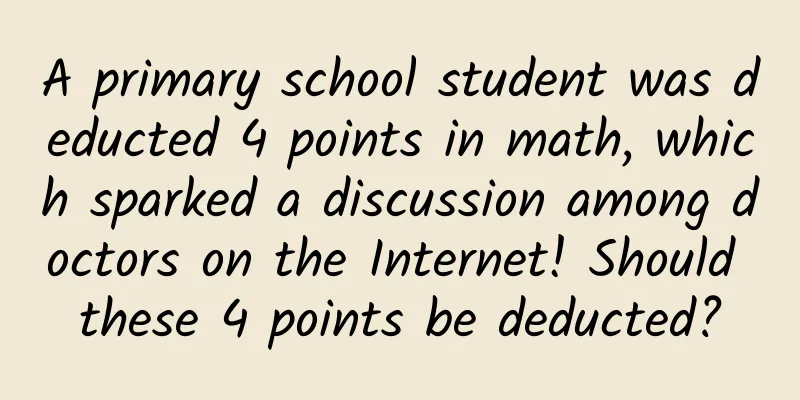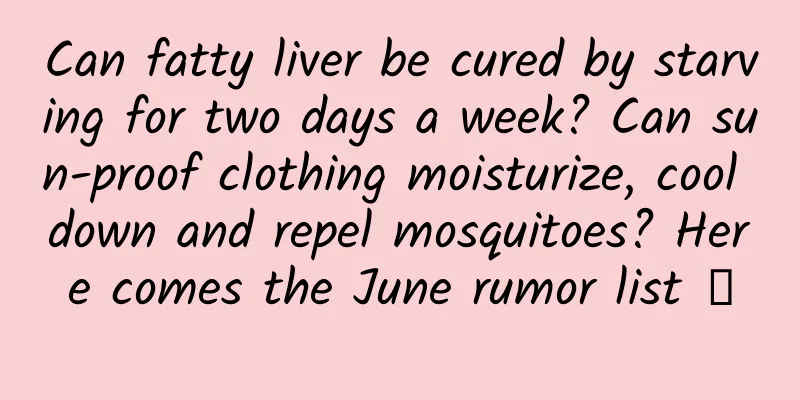A primary school student was deducted 4 points in math, which sparked a discussion among doctors on the Internet! Should these 4 points be deducted?

|
In recent days, a hot search on Weibo #Doctors across the Internet demand that 4 points be returned to primary school students# has sparked discussions on educational concepts. In a primary school math problem, a patient's temperature record chart was given. The question asked the student what information he could get from the chart. The student answered "This patient is getting better soon", which was judged as an incorrect answer and 4 points were deducted. The picture comes from Weibo Many medical staff expressed their approval and support for the children's answers, and emphasized that education should protect children's open-minded thinking: The picture comes from Weibo However, it is true that "education should protect children's open-mindedness", but from the perspective of professional medical personnel, can we say that "this picture can give the message that 'the patient will soon recover'"? The answer is indeed debatable. This temperature chart What information can I get? Let's take a closer look at the temperature data in this picture: May 18, the first day. The body temperature was higher than normal in the morning, afternoon and evening. Although the body temperature dropped slightly at noon, it was still in a feverish state. May 19, the second day. From 0:00, the patient's body temperature showed a continuous downward trend, and by the evening the temperature had dropped to normal; May 20, the third day. The patient's body temperature measured 4 times today did not fluctuate significantly and was within the normal range. So what information can we get from this temperature chart? Actually, it is just the temperature information mentioned above. We can say that the patient had a fever on May 18, that the temperature continued to decline on May 19, and that the temperature was relatively stable on May 20. Can we conclude that the patient is getting well soon? I'm afraid not. Because to draw this conclusion, more additional conditions are needed. For example, some diseases have a recurring fever characteristic. For example, fever in diseases such as malaria and acute pyelonephritis may have alternating high fever and afebrile periods, and the body temperature may remain normal for 1 to several days. In this case, a short "peace" of one day does not mean that the disease has improved. Image from the 9th edition of Diagnostics by People's Health, P11 In addition, some diseases may be accompanied by multiple symptoms, fever is just one of them. Using antipyretics or taking certain treatment measures can temporarily relieve fever symptoms, but the fever may recur after stopping the medication, other symptoms may not be relieved, the root cause of the disease may not be solved, and there is still a long way to go before recovery. This chart only contains temperature information, but does not include specific diseases, medications and treatments , or other symptoms and signs, or changes. Therefore, the patient behind the chart may be getting well soon, or his temperature may have returned to normal for a short time, but he is not close to recovery. Therefore, from a medical perspective, to answer the question "What other information can you get from the above statistical chart?", you can only answer the characteristics of body temperature based on the chart, but you cannot draw the conclusion that "the patient will soon recover." For children It is a good opportunity for cognitive education In most people's daily lives, the most common fever diseases are often common colds, influenza, and some common viral and bacterial infections. These diseases can often heal on their own, or heal on their own after the infection is controlled with proper medication. Therefore, people often observe the phenomenon that "the fever is cured, and the disease will soon be cured." The children may have experienced colds and fevers themselves, or they may have gained such knowledge by observing their family members' illnesses. They not only know that the normal body temperature is around 37°C, but they also combine the common sense they have learned with theoretical content when doing their homework. This is actually a manifestation of being good at observation, association, and accumulation of knowledge, and is indeed worthy of recognition and encouragement. However, we can also take this opportunity to guide children's thinking and cognition to a further level, and realize that it is wrong to draw such a conclusion. The question only gives a temperature chart, and no other information is given. Therefore, when summarizing the chart, you can only talk about the temperature in a matter-of-fact way. You need to be cautious when drawing conclusions about information outside the chart. Your life experience tells you that a drop in body temperature means that the disease is about to heal. In fact, in some more complicated cases, a return to normal body temperature does not mean that the disease is healed. Therefore, "the patient is about to recover" is just a subjective inference based on the body temperature information and one's own knowledge. However, due to the lack of sufficient medical knowledge, this inference is inaccurate. There is nothing shameful about insufficient knowledge. Each of us is constantly learning and improving. No one is born omniscient. But this question tells us that we should always think about the possibility that our knowledge reserves are incomplete and the information we get may not be comprehensive, so we can only describe the information that has been clearly given. Of course, we can also make some speculations in our minds, but we must also remember that these speculations may be wrong. If you can explain this principle to your children, it is actually more valuable than arguing about "whether 4 points should be deducted or not". Planning and production Author: Doctor Fei Dao Duan Yu Review | Tang Qin, Director of the Science Popularization Department of the Chinese Medical Association, National Health Science Popularization Expert Editor: Yang Yaping Proofread by Xu Lailinlin |
>>: Investigation Report on "Human Assets" in Guanghan Palace
Recommend
Baidu promotion guide for the gaming industry!
The peak season for the summer gaming industry is...
How much does it cost to produce a Weifang gardening mini program?
How much does it cost to attract investment in We...
I don't allow you to not know this way to eat pineapple without pricking your mouth (not soaking in salt water)
It’s the season to show off pineapples again! Do ...
B station marketing promotion methods and strategies!
Brand marketing is a long-term thing. The communi...
Aesthetic Corrective Makeup Ultimate Lifting Base Makeup Treatment
Introduction to the resources for the ultimate li...
2020 wage tax deduction standards, wage personal income tax calculation formula
Our country's laws stipulate that if a worker...
How did Uber become so popular? Let’s take a look at Uber’s marketing and branding strategy!
Uber is not just a means of transporting passenge...
Liu Guanqi's Spoken English Course 3.0 Upgraded Version
: : : : : : : : : : : : : : : : : : : : : : : : : ...
Can the lichens that once transformed the Earth's land be used to transform Mars in the future?
Produced by: Science Popularization China Author:...
5 tips to help you effectively increase APP downloads!
When it comes to the number of APP downloads, tho...
I heard you like playing in the water? A picture to understand the "three circuits" of "Hualong One"
...
The average size of the top ten apps in the App Store is four times that of five years ago, and Gmail has grown 19 times
According to the latest report released by market...
How to promote a new APP?
Mobile phone manufacturer cooperation bundling &l...
Is it useful to arrange a Wenchang Tower before the exam?
Many parents ask whether the Wenchang Tower reall...
Understand Toutiao’s information flow ads in one article!
As the largest information flow platform at prese...









